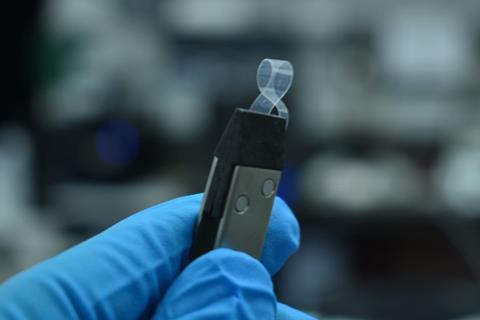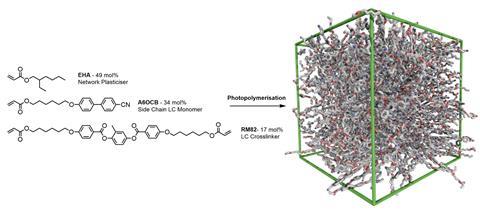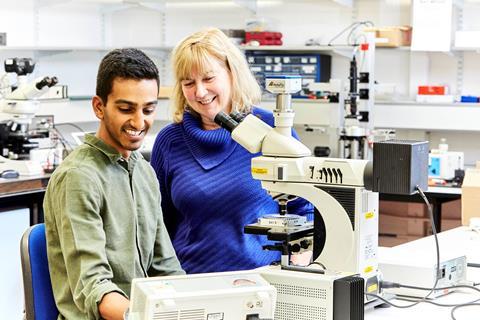The unintuitive properties of LC AuxeTec’s materials mean they thicken when stretched, and could be exploited in body armour and skyscraper windows

Auxeticity – the tendency of a material to become thicker rather than thinner when stretched – is an unusual phenomenon. While the property is uncommon, it’s not unheard of. In nature, to take a few examples, it can be seen in places like the achilles tendon, cat skin and zeolites. But what makes this behaviour attractive is that auxeticity gives materials an edge when it comes to absorbing shock, as well as resisting fractures and tears. That makes them promising in applications where materials need to be durable, such as body armour and glass for buildings and vehicles.
Because of this, researchers have used a number of innovative approaches over the last 40 or so years to create synthetic auxetic materials. One thing all auxetic materials have in common is a negative Poisson’s ratio: the measure of the expansion of a material perpendicular to the force being applied to it. By 3D-printing or otherwise forming complex, porous geometries – honeycomb structures or perforated sheets, for example – it’s possible to create auxeticity in materials that would ordinarily show a positive Poisson’s ratio. However, the porosity required of these materials introduces inherent weaknesses, and the complex manufacturing processes often needed additionally make them expensive to produce. That’s what LC AuxeTec, a new company spinning out from the University of Leeds in the UK, is setting out to solve.
The company was conceived by Helen Gleeson, head of the school of physics and astronomy at the University of Leeds, UK, after her PhD student Devesh Mistry made a serendipitous discovery: the first molecular level, non-porous synthetic auxetic materials, based on liquid crystal elastomers. Liquid crystal elastomers are crosslinked polymer networks that include liquid crystal moieties, analogous to those found in the display of your mobile phone. ‘I had a project with some optometrists at the University of Manchester for some years,’ explains Gleeson. ‘The challenge was: can we use a voltage in a contact lens to make switchable focus contact lenses in the same way that you can change the image you’re displaying on a display device.’
While developing their switchable lenses, they opted to explore liquid crystal elastomers due to their transparency and property of semi-soft elasticity – meaning they can deform for almost no energy cost, but with a change in refractive index, making them potentially suitable for mechanically deformable lenses. However, since none of the available materials had the specific properties they wanted, they set about developing their own formulation. It was while characterising the mechanical and optical properties of the new elastomers that they discovered their unique molecular auxetic properties.
So, what is it that’s fundamentally causing this behaviour? ‘When we first made the discovery, it was easier to know what wasn’t happening at the molecular level than what was,’ says Gleeson. ‘For conventional auxetic materials, they’re network structures, and when they’re stretched, the way in which they deform to give a change where they get thicker is because they change in volume. But we know at a molecular level, our materials don’t change volume. None of the theories actually predict what the auxetic deformation might be. We know that the auxetic responses are linked to some big changes in molecular order that are taking place within the material as it’s put under strain.’
Tuning and exploring
What they do know is that it works – and the elastomers, from a manufacturing point of view, are more attractive than conventionally produced auxetic materials. The bones of the manufacturing process are based on standard processes taken from the liquid crystal display industry, and the materials themselves are produced from commercially available precursors. That gives you a glut of potential commercial applications.

‘We’re trying to focus in areas where there are challenges with incumbent materials,’ comments Keith Rollins, an experienced management consultant and marketing director within the materials industry who was brought on board to help ease the transition toward commercialisation. ‘The potential for these new materials is very wide – the combination of auxetic behaviour, mechanical and optical properties allows a wide range of applications to be targeted. Automotive and architectural glazing interlayers is one such area where we believe auxetic liquid crystal elastomers can provide a performance uplift over presently used materials.’ With the fledgling company in the early stages of talks with partners, Rollins expects commercialisation to take between a year and 18 months – ‘that’s with an aggressive strategy,’ he adds.
And with the materials being fairly new in development, there’s a lot of room for exploration. ‘The other feature of liquid crystal elastomers, in terms of auxetic materials, is their tuneability,’ says Gleeson. ‘We use a particular set of chemical precursors, but there are many available. What we’re making is the nematic liquid crystal network, and there’s the opportunity to build other functionalities in there. There’s a whole lot of expertise in the UK and elsewhere in liquid crystal materials, so building on that knowledge and expertise to then allow you to get different functionalities is something that could be potentially quite exciting.’
LC AuxeTec
Date of founding: October 2020
Location: Leeds, UK
Origin: Spin-out from University of Leeds














No comments yet